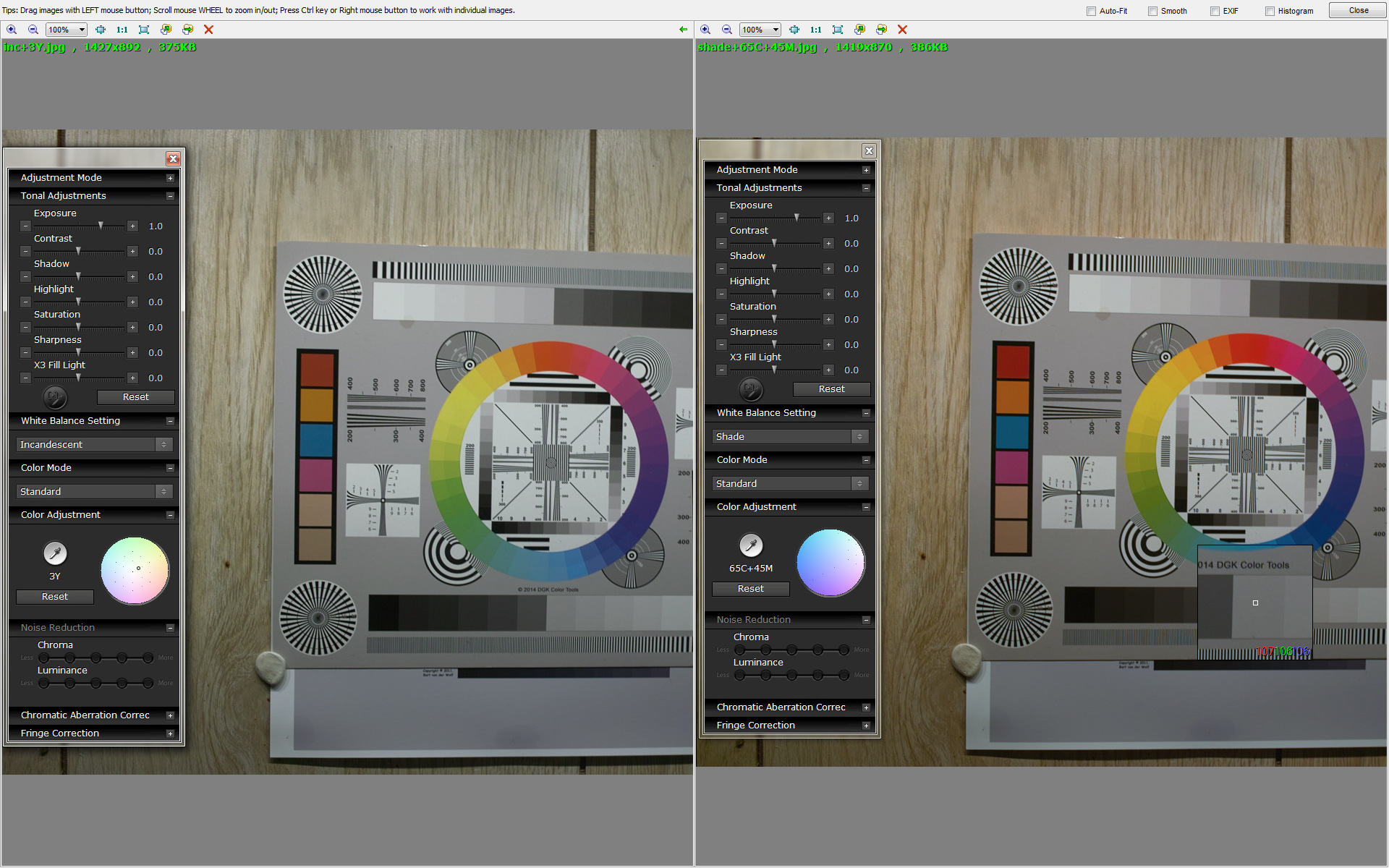In the literature we are told how we usually perceive a white object as white in spite of the lighting conditions. Therefore, we dutifully set our camera WB preset the closest that we can to the ambient light and expect to perhaps make a final 'color correction' in post.
We are also told that a late evening shot (twilight) will not look quite right if perfectly color-corrected in post.
Today I was shooting a target on the wall to check a camera's focusing. The target was lit by a LED strip-light of the warm variety - for which I normally set Incandescent WB in-camera. After clicking on a gray area with the color-correction picker, it obligingly went gray. So far so good . . until, out of curiosity, I glanced at the wall and back at monitor and observed that wall-paneling colors were different!
Intrigued, I went back to the on-screen review image and tried various WB settings followed by the color-picker each time:
It was quite a surprise to note that the 'Shade' preset was the nearest - along with a really big color correction before the paneling on my screen looked about the same as that on the actual wall!
I'm not trying to say anything new here but was pleased to be able to illustrate one of the caveats often associated with "funny" lighting.
Results 1 to 14 of 14
-
31st October 2016, 06:42 PM #1

- Join Date
- Feb 2012
- Location
- Texas
- Posts
- 6,956
- Real Name
- Ted
The Human Eye, White Balance and Color Balancing
Last edited by xpatUSA; 31st October 2016 at 08:38 PM.
-
1st November 2016, 12:13 AM #2
Re: The Human Eye, White Balance and Color Balancing
Interesting Ted, a timely reminder of the complexities of White Balance and the spectrums (spectrii?) of artificial light sources. You mention the human eye in your title - I wonder what happens with folk who suffer from some form of "colour blindness"?
Dave
-
1st November 2016, 12:14 AM #3
Re: The Human Eye, White Balance and Color Balancing
There is of course a caveat - how your monitor is set up

-
1st November 2016, 12:31 AM #4
-
1st November 2016, 12:35 AM #5

- Join Date
- Feb 2012
- Location
- Texas
- Posts
- 6,956
- Real Name
- Ted
Re: The Human Eye, White Balance and Color Balancing
Hi Dave,
One could guess that a "color-blind" person would know what "white" is even though it might look sky-blue pink to them and maybe their brain still makes an adjustment to ambient light anyway, I really don't know.
It's "spectra", BTW, a fast vanishing word - like fora, formulae, etc. I blame the Yanks . . .Last edited by xpatUSA; 1st November 2016 at 12:44 AM.
-
1st November 2016, 12:35 AM #6
-
1st November 2016, 12:39 AM #7
-
1st November 2016, 12:41 AM #8

- Join Date
- Feb 2012
- Location
- Texas
- Posts
- 6,956
- Real Name
- Ted
Re: The Human Eye, White Balance and Color Balancing
Then, if I were to post my 'adjusted' image, it would likely look wrong on your perfectly calibrated monitor . . .
. . . but only if you knew the true color of my wall-paneling.
My P242W monitor is proudly un-calibrated. Like all NEC IPS LCD MultiSyncs, it is quite acceptable straight out of the box for this non-Pro old man.Last edited by xpatUSA; 1st November 2016 at 09:13 AM.
-
1st November 2016, 12:47 AM #9
-
1st November 2016, 01:06 AM #10

- Join Date
- Feb 2012
- Location
- Texas
- Posts
- 6,956
- Real Name
- Ted
-
2nd November 2016, 04:26 PM #11

- Join Date
- Jun 2016
- Location
- lancashire uk
- Posts
- 224
- Real Name
- roy
Re: The Human Eye, White Balance and Color Balancing
I have recently had a cataract operation The difference in whites between my right eye and my left is unbelievable I can't wait to get the other done
-
2nd November 2016, 04:34 PM #12
Re: The Human Eye, White Balance and Color Balancing
Slightly off the subject Ted but can I ask where you got your target from it looks good
Sent from my iPhone using Tapatalk
-
2nd November 2016, 05:07 PM #13

- Join Date
- Feb 2012
- Location
- Texas
- Posts
- 6,956
- Real Name
- Ted
Re: The Human Eye, White Balance and Color Balancing
The site doesn't appear to sell them any more. I got mine off eBay (USA) and it is by no means perfect for serious work. It's printed in (I think) what they call offset lithographic and you can see the dots under a jeweler's loupe. And the scale numbers look wrong for a US letter size print.
I have two and will be glad to send one for nowt if you PM your address.
-
4th November 2016, 04:53 PM #14

 Helpful Posts:
Helpful Posts: 

 Reply With Quote
Reply With Quote
